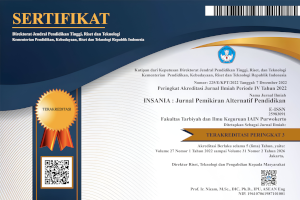Perkembangan Dan Pembelajaran Bahasa Anak Menuju Bahasa Mitos
DOI:
https://doi.org/10.24090/insania.v20i1.1419Abstract
Abstract: The development pattern of a child into the identity not only formed through psychological symptoms, but there are various relationships that shape it. This paper is intended to uncover the connection between psychology, anthropology, and languages. Three domains was a marking on person’s identity. Interralation between otherness, the order of the imaginary and the symbolic is always inherent in the concept of myhth. The formation of the myth itself by language and tagging the objects with the ability of a person’s interpretation is done subjectively. Language as a system of knowledge constructing some tagging become a social discourse, which is believed to be either in the form the sacred, morality, and rationality. Therefore, development and coaching tagging the objects during chillhood become invaluable knowledge as learning/ The way they mark (with the ability to understand) objects will have effects to create a new sign at a later date. Keywords: children’s language, psychology, development, anthropology, language of myth.Downloads
Published
How to Cite
Issue
Section
License
Authors who publish with this journal agree to the following terms:
Authors retain copyright and grant the journal right of first publication with the work simultaneously licensed under a Creative CommonsAttribution-ShareAlike License that allows others to share the work with an acknowledgment of the work's authorship and initial publication in this journal.
Authors are able to enter into separate, additional contractual arrangements for the non-exclusive distribution of the journal's published version of the work (e.g., post it to an institutional repository or publish it in a book), with an acknowledgment of its initial publication in this journal.
Authors are permitted and encouraged to post their work online (e.g., in institutional repositories or on their website) prior to and during the submission process, as it can lead to productive exchanges, as well as earlier and greater citation of published work (See The Effect of Open Access).








